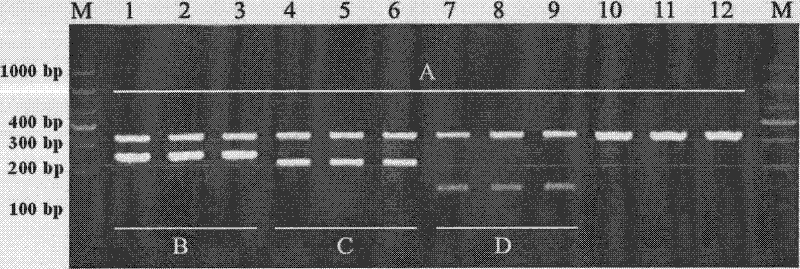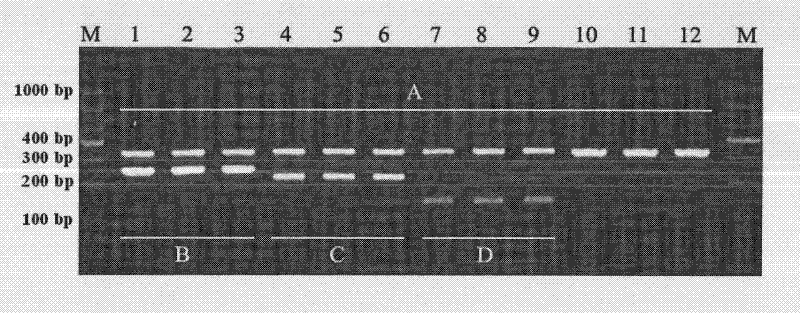PCR method for rapid identification of four types of blue crabs of scylla
A mud crab, rapid technology, applied in the fields of biochemical equipment and methods, microbial determination/inspection, etc., can solve the problems of poor labeling repeatability, difficult to master, low identification accuracy, etc., to achieve simple operation, improve efficiency and The effect of accuracy
- Summary
- Abstract
- Description
- Claims
- Application Information
AI Technical Summary
Problems solved by technology
Method used
Image
Examples
Embodiment 1
[0041] 1. Extraction of Genomic DNA of 4 Scyllas
[0042]Cut a small amount of muscle tissue (about 100-150 mg) from blue crabs and place it in 500 μl tissue extract solution (10 mmol / L Tris-CI, pH 8.0; 100 mmol / L LEDTA, pH 8.0; 100 mmol / L NaCl; 0.5% SDS) Cut into pieces, add proteinase K (final concentration 20mg / ml) and RNase A (final concentration 100μg / ml), mix thoroughly, digest at 55°C for 2-3 hours until clear; mix with phenol: chloroform: isoamyl alcohol solution (volume ratio 25:24:1) twice; then precipitate DNA with 2 volumes of absolute ethanol, wash with 70% ethanol and dry naturally, then dissolve in 50 μL TE (10 mmol / L Tris-HCl, pH8.0; 10mmol / L EDTA, pH8.0); Finally, the DNA concentration was diluted to 100ng / μl and stored at -20°C for later use;
[0043] 2. Mitochondrial COI gene sequence analysis and species-specific primer design
[0044] Download the COI sequences of four kinds of blue crabs from the public database GenBank, use DNAMAN 4.0 biological softwa...
PUM
 Login to View More
Login to View More Abstract
Description
Claims
Application Information
 Login to View More
Login to View More - R&D
- Intellectual Property
- Life Sciences
- Materials
- Tech Scout
- Unparalleled Data Quality
- Higher Quality Content
- 60% Fewer Hallucinations
Browse by: Latest US Patents, China's latest patents, Technical Efficacy Thesaurus, Application Domain, Technology Topic, Popular Technical Reports.
© 2025 PatSnap. All rights reserved.Legal|Privacy policy|Modern Slavery Act Transparency Statement|Sitemap|About US| Contact US: help@patsnap.com



